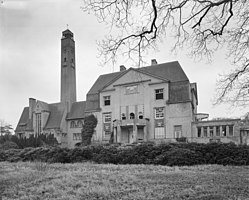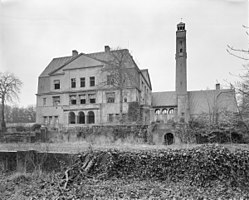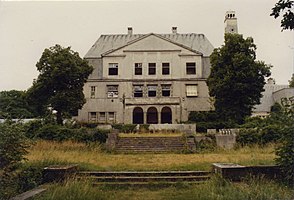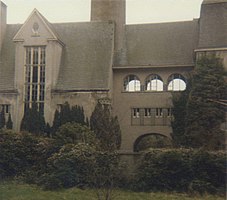
Casa Batlló is a building in the center of Barcelona, Spain. It was designed by Antoni Gaudí, and is considered one of his masterpieces. A remodel of a previously built house, it was redesigned in 1904 by Gaudí and has been refurbished several times after that. Gaudí's assistants Domènec Sugrañes i Gras, Josep Canaleta and Joan Rubió also contributed to the renovation project.

Aerdenhout is a village in the municipality of Bloemendaal, Netherlands. Located in the dunes between Haarlem and the beach town of Zandvoort, it ranks as the wealthiest town in the Netherlands. The name "Aerdenhout" means Andere hout, Dutch for "the other wood", and was given it to distinguish this other wood from the Haarlemmerhout, just south of the city Haarlem.
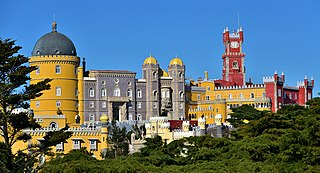
The Pena Palace is a Romanticist castle in São Pedro de Penaferrim, in the municipality of Sintra, on the Portuguese Riviera. The castle stands on the top of a hill in the Sintra Mountains above the town of Sintra, and on a clear day it can be easily seen from Lisbon and much of its metropolitan area. It is a national monument and constitutes one of the major expressions of 19th-century Romanticism in the world. The palace is a UNESCO World Heritage Site and one of the Seven Wonders of Portugal. It is also used for state occasions by the President of the Portuguese Republic and other government officials.
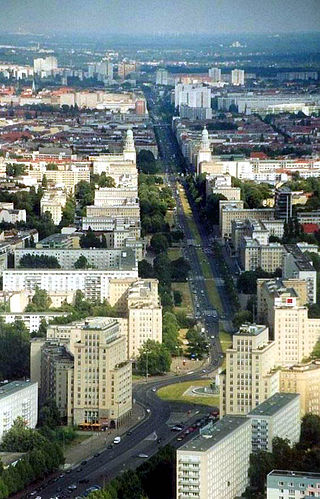
Karl-Marx-Allee is a monumental socialist boulevard built by the GDR between 1952 and 1960 in Berlin Friedrichshain and Mitte. Today the boulevard is named after Karl Marx. It should not be confused with the Karl-Marx-Straße in the Neukölln district of Berlin.

The Vienna Secession is an art movement, closely related to Art Nouveau, that was formed in 1897 by a group of Austrian painters, graphic artists, sculptors and architects, including Josef Hoffman, Koloman Moser, Otto Wagner and Gustav Klimt. They resigned from the Association of Austrian Artists in protest against its support for more traditional artistic styles. Their most influential architectural work was the Secession exhibitions hall designed by Joseph Maria Olbrich as a venue for expositions of the group. Their official magazine was called Ver Sacrum, which published highly stylised and influential works of graphic art. In 1905 the group itself split, when some of the most prominent members, including Klimt, Wagner, and Hoffmann, resigned in a dispute over priorities, but it continued to function, and still functions today, from its headquarters in the Secession Building. In its current form, the Secession exhibition gallery is independently led and managed by artists.

The Saxon Garden is a 15.5–hectare public garden in central (Śródmieście) Warsaw, Poland, facing Piłsudski Square. It is the oldest public park in the city. Founded in the late 17th century, it was opened to the public in 1727 as one of the first publicly accessible parks in the world.

The Porto Cathedral is a Roman Catholic church located in the historical centre of the city of Porto, Portugal. It is one of the city's oldest monuments and one of the most important local Romanesque monuments.

The Palace on the Isle, also known as Baths Palace, is a classicist palace in Warsaw's Royal Baths Park, the city's largest park, occupying over 76 hectares of the city center.

Max Laeuger was a German architect, artist, and ceramicist. He was born and died in Lörrach, Baden-Württemberg.

The Westerpark is a public urban park in Amsterdam, Netherlands. The former borough (stadsdeel) of Westerpark is named after the park, as is the current neighborhood.

The Great Mosque of Herat or "Jami Masjid of Herat", is a mosque in the city of Herat, in the Herat Province of north-western Afghanistan. It was built by the Ghurids, under the rule of Sultan Ghiyath al-Din Muhammad Ghori, who laid its foundation in 1200 CE. Later, it was extended several times as Herat changed rulers down the centuries from the Kartids, Timurids, Mughals and then the Uzbeks, all of whom supported the mosque. The fundamental structure of the mosque from the Ghurid period has been preserved, but parts have been added and modified. The Friday mosque in Herat was given its present appearance during the 20th century.

The New Synagogue in Ostrów Wielkopolski, Poland, is located in the city's center on 21 Raszkowska Street, which was the northern edge of the former Jewish district. Currently, this is the only preserved metropolitan synagogue. It is built in the once very popular Moorish Revival style. It is the most precious monument of religious architecture in Ostrów Wielkopolski. Long neglected, the synagogue has been fully restored in 2010. See the municipal website for updates:
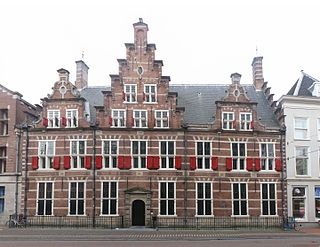
The Gemeenlandshuis van Rijnland on the Breestraat in Leiden is the oldest Gemeenlandshuis of the Netherlands that kept its function until the current century. Currently, it is still in use by the Hoogheemraadschap van Rijnland, but only for meetings and special occasions. Their day-to-day seat of water management is housed today on the Archimedesweg in Leiden.

The K XIV-class submarine was a class of five submarines, built for the Royal Netherlands Navy. Used for patrols in the Dutch colonial waters. The class comprised K XIV, K XV, K XVI, K XVII and K XVIII. The submarines diving depth was 80 m (260 ft). Three of the five ships were lost in World War II

Grand Mound Town Hall and Waterworks Historic District, also known as Hose house, pump house, is a historic district located in Grand Mound, Iowa, United States. It was listed on the National Register of Historic Places in 2001. The district is composed of two buildings and the town's water tower.

Cannenburg Castle or Cannenburch Castle is a watercastle in the Netherlands. It is situated in Vaassen, a town in the province of Gelderland.
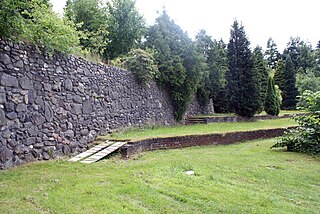
The Muur van Mussert is all that remains of a rally ground with buildings and monuments planned by Anton Mussert and his National Socialist Movement in the Netherlands (NSB) to house party meetings and hold national events to celebrate national-socialist thought in the Netherlands. The wall was built in 1938, on a plot of land the NSB had acquired near Lunteren in Gelderland, in the center of the country, and was inspired by the Nazi party rally grounds in Nuremberg.
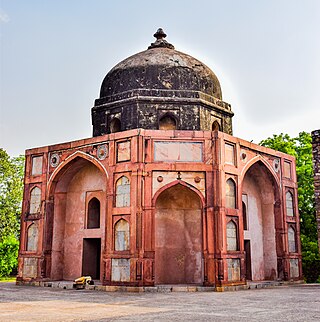
The Afsarwala tomb complex consists of a tomb and mosque, located inside the Humayun's Tomb complex in Delhi, India. The mausoleum houses the tomb of an unknown person. The tomb, together with other structures, forms the UNESCO World Heritage Site of Humayun's tomb complex.

Ter Horst Castle is a castle northeast of the village of Loenen, in the Dutch province of Gelderland, on the road to Klarenbeek. In 1557, the then mayor of Arnhem Wynant Hacfort had the castle built.

Hillenraad Castle is a 14th century square water castle located on the south side of Swalmen in the municipality of Roermond in the province of Limburg. The castle is located in the middle of an estate near the village of Boukoul. It consists of a moated main building with four corner towers, an outer castle, several outbuildings and a castle park. Hillenraad Castle has been a protected national monument since 1970. The entire complex consists of twenty separate entries in the national monument register, including the main building, the outbuildings and a number of elements in the park. The castle is not open to the public.

